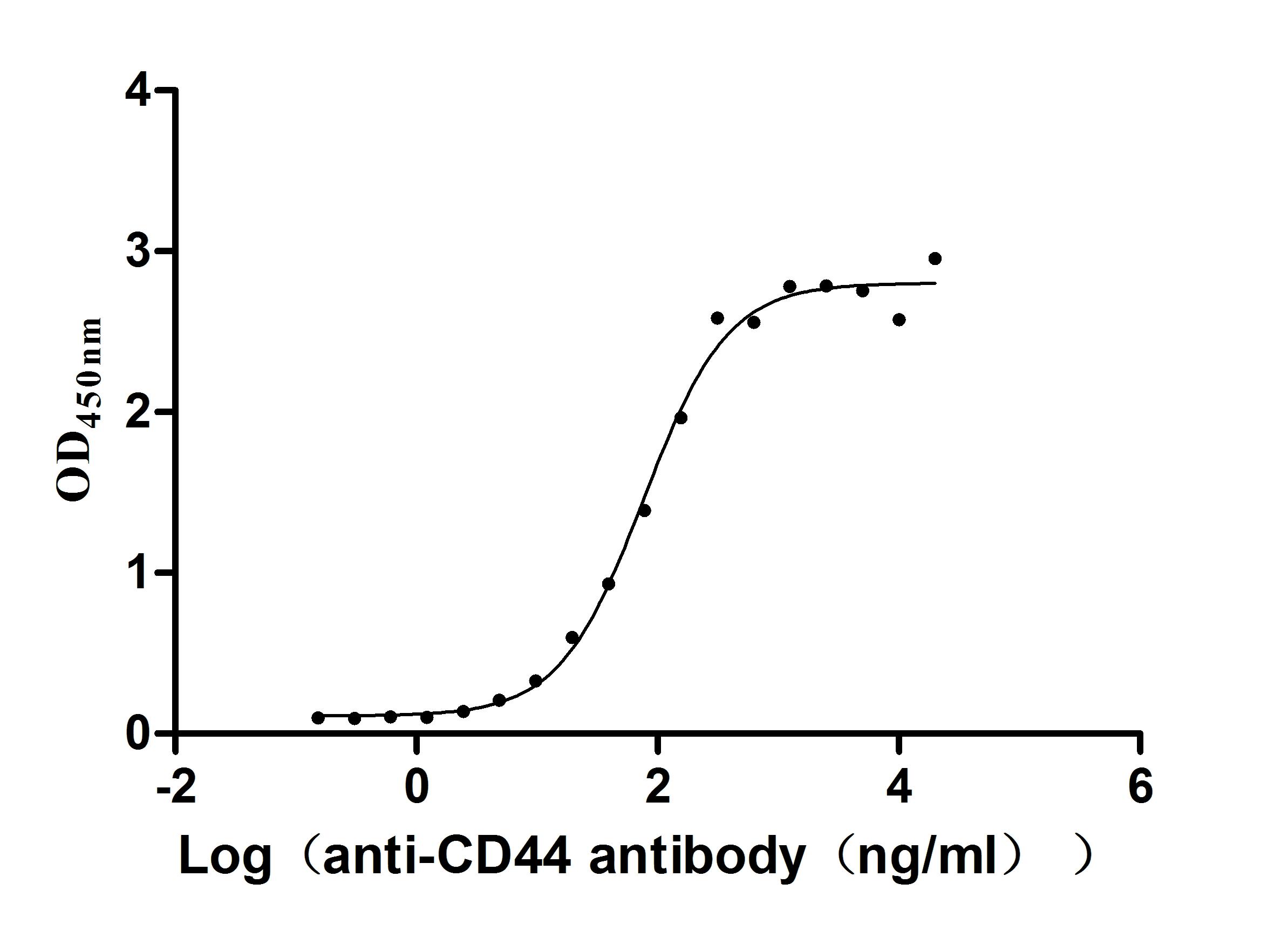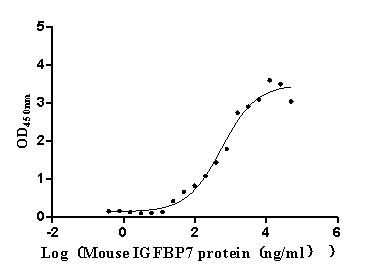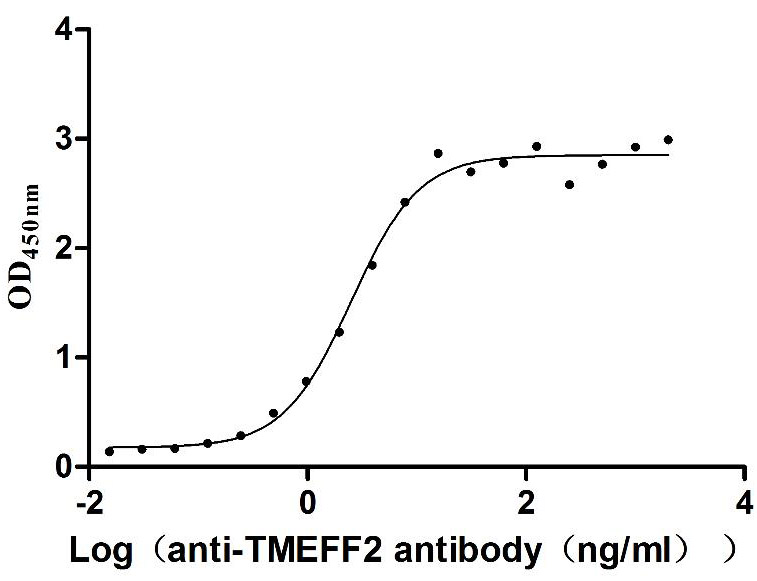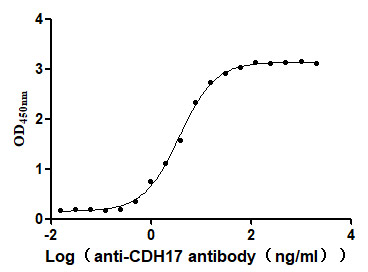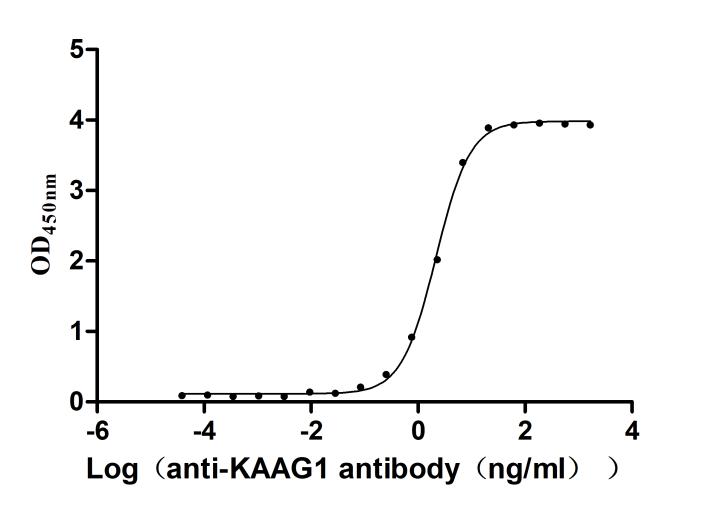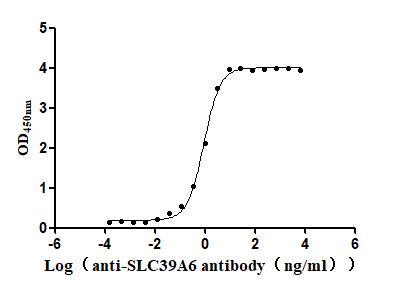Recombinant Escherichia coli Peptide chain release factor 3 (prfC)
-
中文名稱:大腸桿菌prfC重組蛋白
-
貨號:CSB-EP358978ENV-B
-
說明書:
-
規格:
-
來源:E.coli
-
共軛:Avi-tag Biotinylated
E. coli biotin ligase (BirA) is highly specific in covalently attaching biotin to the 15 amino acid AviTag peptide. This recombinant protein was biotinylated in vivo by AviTag-BirA technology, which method is BriA catalyzes amide linkage between the biotin and the specific lysine of the AviTag.
-
其他:
產品詳情
-
純度:>85% (SDS-PAGE)
-
基因名:prfC
-
Uniprot No.:
-
別名:prfC; miaD; tos; b4375; JW5873; Peptide chain release factor RF3; RF-3
-
種屬:Escherichia coli (strain K12)
-
蛋白長度:Full Length of Mature Protein
-
表達區域:2-529
-
氨基酸序列TLSPYLQEV AKRRTFAIIS HPDAGKTTIT EKVLLFGQAI QTAGTVKGRG SNQHAKSDWM EMEKQRGISI TTSVMQFPYH DCLVNLLDTP GHEDFSEDTY RTLTAVDCCL MVIDAAKGVE DRTRKLMEVT RLRDTPILTF MNKLDRDIRD PMELLDEVEN ELKIGCAPIT WPIGCGKLFK GVYHLYKDET YLYQSGKGHT IQEVRIVKGL NNPDLDAAVG EDLAQQLRDE LELVKGASNE FDKELFLAGE ITPVFFGTAL GNFGVDHMLD GLVEWAPAPM PRQTDTRTVE ASEDKFTGFV FKIQANMDPK HRDRVAFMRV VSGKYEKGMK LRQVRTAKDV VISDALTFMA GDRSHVEEAY PGDILGLHNH GTIQIGDTFT QGEMMKFTGI PNFAPELFRR IRLKDPLKQK QLLKGLVQLS EEGAVQVFRP ISNNDLIVGA VGVLQFDVVV ARLKSEYNVE AVYESVNVAT ARWVECADAK KFEEFKRKNE SQLALDGGDN LAYIATSMVN LRLAQERYPD VQFHQTREH
-
蛋白標簽:Tag?type?will?be?determined?during?the?manufacturing?process.
The tag type will be determined during production process. If you have specified tag type, please tell us and we will develop the specified tag preferentially. -
產品提供形式:Lyophilized powder Warning: in_array() expects parameter 2 to be array, null given in /www/web/cusabio_cn/public_html/caches/caches_template/default/content/show_product_protein.php on line 662
Note: We will preferentially ship the format that we have in stock, however, if you have any special requirement for the format, please remark your requirement when placing the order, we will prepare according to your demand. -
復溶:We recommend that this vial be briefly centrifuged prior to opening to bring the contents to the bottom. Please reconstitute protein in deionized sterile water to a concentration of 0.1-1.0 mg/mL.We recommend to add 5-50% of glycerol (final concentration) and aliquot for long-term storage at -20℃/-80℃. Our default final concentration of glycerol is 50%. Customers could use it as reference.
-
儲存條件:Store at -20°C/-80°C upon receipt, aliquoting is necessary for mutiple use. Avoid repeated freeze-thaw cycles.
-
保質期:The shelf life is related to many factors, storage state, buffer ingredients, storage temperature and the stability of the protein itself.
Generally, the shelf life of liquid form is 6 months at -20°C/-80°C. The shelf life of lyophilized form is 12 months at -20°C/-80°C. -
貨期:Delivery time may differ from different purchasing way or location, please kindly consult your local distributors for specific delivery time.Note: All of our proteins are default shipped with normal blue ice packs, if you request to ship with dry ice, please communicate with us in advance and extra fees will be charged.
-
注意事項:Repeated freezing and thawing is not recommended. Store working aliquots at 4°C for up to one week.
-
Datasheet :Please contact us to get it.
靶點詳情
-
功能:Increases the formation of ribosomal termination complexes and stimulates activities of RF-1 and RF-2. It binds guanine nucleotides and has strong preference for UGA stop codons. It may interact directly with the ribosome. The stimulation of RF-1 and RF-2 is significantly reduced by GTP and GDP, but not by GMP.
-
基因功能參考文獻:
- Data show that peptide chain release factor RF-3 (RF3) hydrolyzes GTP and dissociates from the ribosome before peptide chain release factor RF-1 (RF1)dissociation. PMID: 27779391
- Together, these data define a more precise role for RF3 in translation termination and provide insights into the function of this family of translational GTPases PMID: 24667215
- Ordering of critical elements of switch loop I and the P loop, which help to form the GTPase catalytic site, are caused by interactions between the G domain of RF3. PMID: 22187675
- Data suggest how RF3, by stabilizing the hybrid state of the ribosome, facilitates the dissociation of class I release factors. PMID: 21903932
- Study examines the role of RF3 in the bacterial cell and show that the deletion of this gene sensitizes cells to other perturbations that reduce the overall fidelity of protein synthesis. PMID: 22000017
- Data show a novel class of RF3 mutations specifically defective in the tRNA drop-off reaction, and these mutations suggest differential molecular pathways closely related to the guanine nucleotide modes of RF3. PMID: 20043913
- The data show that RF3*GTP binding induces large conformational changes in the ribosome, which break the interactions of the class I RF with both the decoding center and the GTPase-associated center leading to the release of the class I RF. PMID: 17540173
顯示更多
收起更多
-
亞細胞定位:Cytoplasm.
-
蛋白家族:TRAFAC class translation factor GTPase superfamily, Classic translation factor GTPase family, PrfC subfamily
-
數據庫鏈接:
KEGG: ecj:JW5873
STRING: 316385.ECDH10B_4532
Most popular with customers
-
Recombinant Macaca fascicularis CD44 antigen (CD44), partial (Active)
Express system: Mammalian cell
Species: Macaca fascicularis (Crab-eating macaque) (Cynomolgus monkey)
-
Recombinant Mouse Complement component C1q receptor (Cd93), partial (Active)
Express system: Mammalian cell
Species: Mus musculus (Mouse)
-
Recombinant Human Tomoregulin-2 (TMEFF2), partial (Active)
Express system: Mammalian cell
Species: Homo sapiens (Human)
-
Recombinant Human Cadherin-17 (CDH17), partial (Active)
Express system: Mammalian cell
Species: Homo sapiens (Human)
-
Recombinant Human Kidney-associated antigen 1 (KAAG1) (Active)
Express system: E.coli
Species: Homo sapiens (Human)
-
Recombinant Macaca fascicularis Zinc transporter ZIP6 isoform X1(SLC39A6),partial (Active)
Express system: Baculovirus
Species: Macaca fascicularis (Crab-eating macaque) (Cynomolgus monkey)
-
Express system: Mammalian cell
Species: Homo sapiens (Human)


